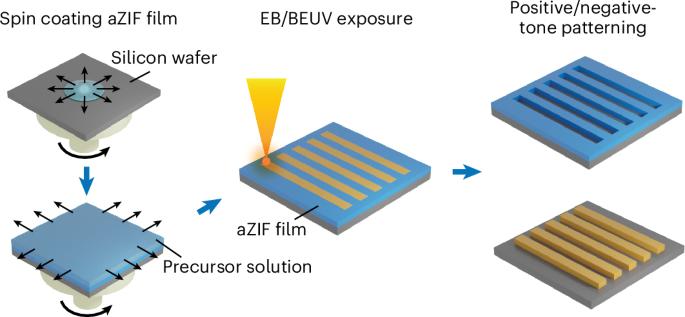Spin-on deposition of amorphous zeolitic imidazolate framework films for lithography applications
引用次数: 0
Abstract
Amorphous zeolitic imidazolate framework (aZIF) films have been recently introduced as resists for electron beam and extreme ultraviolet lithography. aZIFs are also being considered for separation applications, including thin film membranes. However, the reported methods for aZIF deposition are currently based on highly empirical trial-and-error approaches that hinder control of film composition, thickness and uniformity as well as scale-up and transferability to different coating geometries. This work presents a method for depositing aZIF films with controllable thickness using dilute precursors mixed immediately before encountering the substrate. Importantly, the method is amenable to quantitative analysis by computational fluid dynamics to extract intrinsic deposition rates and limiting reactant transport diffusivities, enabling predictive physics-based modeling of the deposition process. This allows the deposition method to be adapted for spin coating on silicon wafers to prepare high-quality aZIF films with consistently controlled thickness. Using this approach, high-resolution resist performance and wafer-scale use for beyond extreme-ultraviolet lithography of aZIF films is demonstrated. The lack of reliable coating methods for amorphous zeolitic imidazolate framework (aZIF) materials hinders their development for applications such as photolithography and separation membranes. Supported by computational fluid dynamics modeling, the authors develop a spin-coating technique to deposit aZIF films from dilute precursors and demonstrate their wafer-scale use in advanced lithographic processes.

光刻用非晶咪唑酸沸石骨架膜的自旋沉积
无定形咪唑酸沸石骨架(aZIF)薄膜近年来被广泛应用于电子束光刻和极紫外光刻。azif也被考虑用于分离应用,包括薄膜。然而,目前报道的aZIF沉积方法是基于高度经验的试错方法,这阻碍了对薄膜成分、厚度和均匀性的控制,以及对不同涂层几何形状的放大和可转移性的控制。这项工作提出了一种沉积具有可控厚度的aZIF薄膜的方法,使用在遇到衬底之前立即混合的稀释前驱体。重要的是,该方法可以通过计算流体动力学进行定量分析,以提取固有沉积速率和限制反应物输运扩散系数,从而实现沉积过程的预测物理建模。这使得沉积方法适用于硅晶圆上的自旋镀膜,以制备具有一致控制厚度的高质量aZIF薄膜。利用这种方法,证明了aZIF薄膜的高分辨率抗蚀性能和超极紫外光刻的晶圆级应用。无定形沸石咪唑盐框架(aZIF)材料缺乏可靠的涂层方法,阻碍了其在光刻和分离膜等应用领域的发展。在计算流体动力学模型的支持下,作者开发了一种旋转镀膜技术,从稀释的前驱体中沉积aZIF薄膜,并展示了它们在先进光刻工艺中的晶圆级应用。
本文章由计算机程序翻译,如有差异,请以英文原文为准。
求助全文
约1分钟内获得全文
求助全文

 求助内容:
求助内容: 应助结果提醒方式:
应助结果提醒方式:


